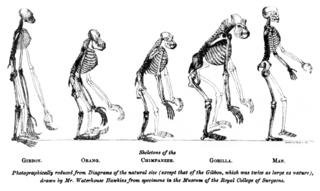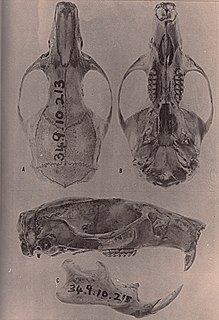In rodents, sphenopalatine vacuities are perforations of the roof of the mesopterygoid fossa, the open space behind the palate, in between the parapterygoid fossae. [1] They may perforate the presphenoid or basisphenoid bone. [2] Their development and form are variable between and within species, and features of the sphenopalatine vacuities have been used as characters in cladistic analyses. [3]

Rodents are mammals of the order Rodentia, which are characterized by a single pair of continuously growing incisors in each of the upper and lower jaws. About 40% of all mammal species are rodents ; they are found in vast numbers on all continents except Antarctica. They are the most diversified mammalian order and live in a variety of terrestrial habitats, including human-made environments.

The palate is the roof of the mouth in humans and other mammals. It separates the oral cavity from the nasal cavity. A similar structure is found in crocodilians, but in most other tetrapods, the oral and nasal cavities are not truly separate. The palate is divided into two parts, the anterior bony hard palate and the posterior fleshy soft palate.

Cladistics is an approach to biological classification in which organisms are categorized in groups ("clades") based on the most recent common ancestor. Hypothesized relationships are typically based on shared derived characteristics (synapomorphies) that can be traced to the most recent common ancestor and are not present in more distant groups and ancestors. A key feature of a clade is that a common ancestor and all its descendants are part of the clade. Importantly, all descendants stay in their overarching ancestral clade. For example, if within a strict cladistic framework the terms animals, bilateria/worms, fishes/vertebrata, or monkeys/anthropoidea would be used, these terms would include humans. Many of these terms are normally used paraphyletically, outside of cladistics, e.g. as a 'grade'. Radiation results in the generation of new subclades by bifurcation.
Among Oryzomyini, a mainly South American group, a 2006 study distinguished three character states—large, wide vacuities, as among others in Oligoryzomys and Holochilus ; small, narrow vacuities, as among others in Lundomys and Nephelomys ; and no or vestigial vacuities, as among others in Mindomys and Oryzomys . [2] Phyllotini all have very large sphenopalatine vacuities, as does Sigmodon. The vacuities in Reithrodon , formerly considered a phyllotine, are especially large. [4] Nyctomys is special in having sphenopalatine vacuities restricted to the basisphenoid bone. [2] Character polarity for the development of the vacuities in Cricetidae is difficult to determine, but their absence may be primitive in the Neotominae. [4]

Oryzomyini, or rice rat, is a tribe of rodents in the subfamily Sigmodontinae of family Cricetidae. It includes about 120 species in about thirty genera, distributed from the eastern United States to the southernmost parts of South America, including many offshore islands. It is part of the clade Oryzomyalia, which includes most of the South American Sigmodontinae.

Oligoryzomys is a genus of rodents in the tribe Oryzomyini of family Cricetidae. Many species are known as pygmy rice rats or colilargos. The genus is found from Mexico to Tierra del Fuego and includes about 17 species.
Holochilus is a genus of semiaquatic rodents in the tribe Oryzomyini of family Cricetidae, sometimes called marsh rats. It contains three living species, H. brasiliensis, H. chacarius, and H. sciureus, which are widely distributed in South America east of the Andes. A fourth species from the Pleistocene of Bolivia was formerly classified as H. primigenus, but is now placed in the genus Reigomys.
The development of sphenopalatine vacuities has also been used to distinguish among members of the Sciurini group of squirrels. [5]

Sciurini is a tribe that includes about forty species of squirrels, mostly from the Americas. It includes five living genera—the American dwarf squirrels, Microsciurus; the Bornean Rheithrosciurus; the widespread American and Eurasian tree squirrels of the genus Sciurus, which includes some of the best known squirrel species; the Central American Syntheosciurus; and the American pine squirrels, Tamiasciurus. Like other arboreal squirrels, they are sometimes referred to as tree squirrels.

Squirrels are members of the family Sciuridae, a family that includes small or medium-size rodents. The squirrel family includes tree squirrels, ground squirrels, chipmunks, marmots, flying squirrels, and prairie dogs amongst other rodents. Squirrels are indigenous to the Americas, Eurasia, and Africa, and were introduced by humans to Australia. The earliest known squirrels date from the Eocene period and are most closely related to the mountain beaver and to the dormouse among other living rodent families.









